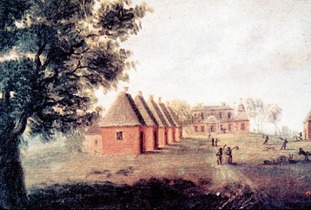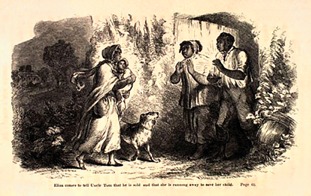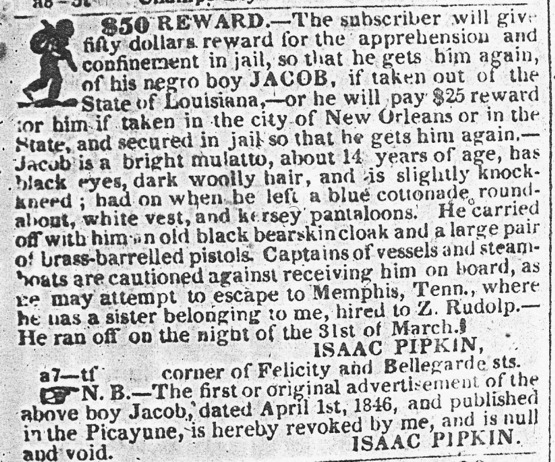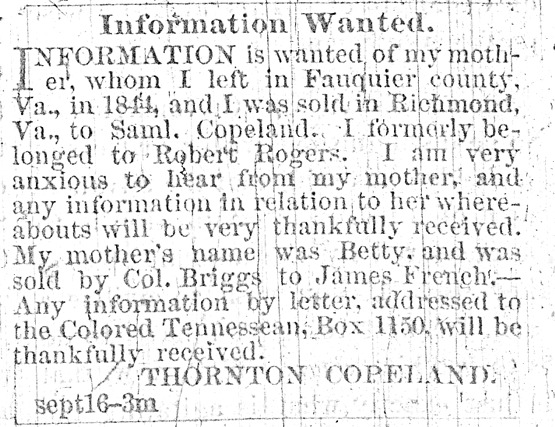


How Slavery Affected
African American Families
In some ways enslaved African American families very much resembled other families who lived in other times and places and under vastly different circumstances. Some husbands and wives loved each other; some did not get along. Children sometimes abided by parent’s rules; other times they followed their own minds. Most parents loved their children and wanted to protect them. In some critical ways, though, the slavery that marked everything about their lives made these families very different. Belonging to another human being brought unique constrictions, disruptions, frustrations, and pain.
Enslaved people could not legally marry in any American colony or state. Colonial and state laws considered them property and commodities, not legal persons who could enter into contracts, and marriage was, and is, very much a legal contract. This means that until 1865 when slavery ended in this country, the vast majority of African Americans could not legally marry. In northern states such as New York, Pennsylvania, or Massachusetts, where slavery had ended by 1830, free African Americans could marry, but in the slave states of the South, many enslaved people entered into relationships that they treated like marriage; they considered themselves husbands and wives even though they knew that their unions were not protected by state laws.
Some enslaved people lived in nuclear families with a mother, father, and children. In these cases each family member belonged to the same owner. Others lived in near-nuclear families in which the father had a different owner than the mother and children. Both slaves and slaveowners referred to these relationships between men and women as “abroad marriages.” A father might live several miles away on a distant plantation and walk, usually on Wednesday nights and Saturday evenings to see his family as his obligation to provide labor for an owner took precedence over his personal needs.
This use of unpaid labor to produce wealth lay at the heart of slavery in America. Enslaved people usually worked from early in the morning until late at night. Women often returned to work shortly after giving birth, sometimes running from the fields during the day to feed their infants. On large plantations or farms, it was common for children to come under the care of one enslaved woman who was designated to feed and watch over them during the day while their parents worked. By the time most enslaved children reached the age of seven or eight they were also assigned tasks including taking care of owner’s young children, fanning flies from the owner’s table, running errands, taking lunch to owners’ children at school, and eventually, working in the tobacco, cotton, corn, or rice fields along with adults.
 Slave quarters. Mulberry Plantation, South Carolina. |
|
Enslaved people lived with the perpetual possibility of separation through the sale of one or more family members. Slaveowners’ wealth lay largely in the people they owned, therefore, they frequently sold and or purchased people as finances warranted. A multitude of scenarios brought about sale. An enslaved person could be sold as part of an estate when his owner died, or because the owner needed to liquidate assets to pay off debts, or because the owner thought the enslaved person was a troublemaker. A father might be sold away by his owner while the mother and children remained behind, or the mother and children might be sold. Enslaved families were also divided for inheritance when an owner died, or because the owners’ adult children moved away to create new lives, taking some of the enslaved people with them. These decisions were, of course, beyond the control of the people whose lives they affected most. Sometimes an enslaved man or woman pleaded with an owner to purchase his or her spouse to avoid separation. The intervention was not always successful. Historian Michael Tadman has estimated that approximately one third of enslaved children in the upper South states of Maryland and Virginia experienced family separation in one of three possible scenarios: sale away from parents; sale with mother away from father; or sale of mother or father away from child. The fear of separation haunted adults who knew how likely it was to happen. Young children, innocently unaware of the possibilities, learned quickly of the pain that such separations could cost.
Paradoxically, despite the likelihood of breaking up families, family formation actually helped owners to keep slavery in place. Owners debated among themselves the benefits of enslaved people forming families. Many of them reasoned that having families made it much less likely that a man or woman would run away, thus depriving the owner of valuable property. Many owners encouraged marriage, devised the practice of “jumping the broom” as a ritual that enslaved people could engage in, and sometimes gave small gifts for the wedding. Some owners honored the choices enslaved people made about whom their partners would be; other owners assigned partners, forcing people into relationships they would not have chosen for themselves.
Just as owners used the formation of family ties to their own advantage, abolitionists used the specter of separation to argue against the institution of slavery. Frederick Douglass, who was enslaved in Maryland before he escaped to Massachusetts and became an abolitionist stridently working to end slavery, began the narrative of his life by examining
 "Eliza comes to tell Uncle Tom that he is sold and that she is running away to save her baby." From Uncle Tom's Cabin. |
|
Following the Civil War, when slavery finally ended in America after nearly two hundred and fifty years, former slaves took measures to formalize their family relations, to find family members, and to put their families back together. During slavery, many people formed new families after separation, but many of them also held on to memories of the loved ones they had lost through sale. Starting in 1866, hundreds of people placed advertisements in newspapers searching for family members. They also sent letters to the Freedmen’s Bureau to enlist the government’s assistance in finding relatives. Parents returned to the places from which they had been sold to take their children from former owners who wanted to hold on to them to put them to work. And, thousands of African American men and women formalized marriages now that it was possible to do so. Some married the person with whom they had lived during slavery, while others legalized new relationships.
Guiding Student Discussion
I find that the most exhilarating and meaningful discussions occur when students have an opportunity to engage with primary sources. Working with documents helps students to develop analytical and investigative skills and can give them a sense of how historians come to their understandings of the past. Interacting directly with documents can also help students to retain information and ideas. I offer a few primary sources here that should stimulate discussion and help students to imagine what life may have been like in the past.
Legislation
As English colonists began the process of putting slavery into place, they paid careful attention to family arrangements among enslaved people. Legislators in Virginia and Massachusetts passed laws in the 1600s making clear that the rules would be different for slaves and that family would not offer protection from slavery. The following is a Virginia statute that changed the English common law provision that a father’s status determined his children’s status.
Virginia Statutes: ACT XII (1662) (Hening 2:170)
Negro womens children to serve according to the condition of the mother
Whereas some doubts have arisen whether children got by any Englishman upon a negro woman should be slave or free, Be it therefore enacted and declared by this present grand assembly, that all children borne in this country shall be held bond or free only according to the condition of the mother, and that if any Christian shall commit fornication with a negro man or woman, he or she so offending shall pay double the fines imposed by the former act.
Students will likely find the language of this statute a bit confusing, but will also enjoy deciphering it. Depending on the age and maturity of your students and the strictures of your school district, you may want to cut the last section regarding fornication. You can have an interesting discussion here about the role of the state (or colony in this case) in determining who would be a slave and who would be free. A child’s status was set at birth and followed that of its mother, not the father as might have been expected. Ask students why they think slaveowners, many of whom were represented in colonial legislatures, would have wanted this provision. How did it help them? What concerns were they attempting to satisfy here? What would be the status of a child born to an enslaved mother and white, slaveowning father? What impact might this have had on black men who were being denied the right to determine the status of their children even though they lived in a patriarchal society in which men were generally dominant?
Note for students that because whites were not enslaved in America, the children of a white mother and enslaved father was automatically free, but in some colonies and later states, legislation punished white women and their mixed-race children by apprenticing the children until adulthood and extending the period of service for the white woman if she was an indentured servant. What were the implications of such punishment? What message did legislatures send about the ideal racial makeup of families?
Conflicts over whether parents or owners had control over enslaved children.
The following paragraph is from Incidents in the Life of a Slave Girl, written by Harriet Jacobs, a former slave, in 1861.
My father, by his nature, as well as by the habit of transacting business as a skilful mechanic, had more of the feelings of a freeman than is common among slaves. My brother was a spirited boy; and being brought up under such influences, he early detested the name of master and mistress. One day, when his father and his mistress had happened to call him at the same time, he hesitated between the two; being perplexed to know which had the strongest claim upon his obedience. He finally concluded to go to his mistress. When my father reproved him for it, he said, “You both called me, and I didn’t know which I ought to go to first.”
“You are my child,” replied our father, “and when I call you, you should come immediately, if you have to pass through fire and water.”
Poor Willie! He was now to learn his first lesson of obedience to a master.1
In this brief passage, Jacobs takes us into the world of one enslaved family. You might begin the discussion by encouraging students to describe the scene in their own words. This exercise will require them to focus closely on the details of the episode. As a child Jacobs lived in Edenton, North Carolina, in the eastern, highly agricultural part of the state. This incident likely took place in the yard between the owner’s home and where the slaves lived, a space that would have been occupied by both owner and owned. Ask students to think about what the setting might have been.
Jacobs describes William as “perplexed,” what calculations do students think he made in the moments before he went to his owner’s wife? Why did he have to think about it? What lessons had he already learned about power as it related to him, an enslaved child? Why did he make decision that he ultimately did?
This incident illuminates tensions in the roles that enslaved people had to play in their lives. William’s father understood that someone else owned both him and his son, but he seems to have wanted to resist being completely powerless. He appealed to his son to recognize that their relationship made the father as important, and possibly as powerful, as their owner. This father’s reaction raises interesting questions about manhood as well as the prerogatives of enslaved parents. Ask student to explore these tensions. How do they imagine that William’s father felt? What do his words tell us about his feelings? What claims was he making despite his status as a slave. Did he put his son at risk by demanding obedience?
Note for the students that although many enslaved children grew up apart from their fathers, some had fathers in their homes. This is one example. How do students imagine that other enslaved parents might have handled similar dilemmas regarding obedience and loyalty?
Running away to find family members. This ad is from the New Orleans Picayune, April 11, 1846.
 |
This advertisement for a teenaged boy who ran away is compelling on many levels. In this context, however, the last lines of the ad are most relevant: “Captains of vessels and steamboats are cautioned against receiving him on board, as he may attempt to escape to Memphis, Tenn., where he has a sister belonging to me, hired to Z. Randolp.” As with so many enslaved people who ran away, Jacob went in search of family. Encourage students to do a close reading and analysis of the ad. How do they suppose Isaac Pipkin knew what clothing Jacob had on when he left? Is it likely that an enslaved boy owned a black bearskin coat? What about the pistols? Who did those likely belong to? Jacob was quite a distance away from his sister—how do students imagine Jacob knew where she was?
Information Wanted Ads. This advertisement was placed in the Colored Tennessean newspaper in Nashville, Tennessee on October 7, 1865.
 |
INFORMATION is wanted of my mother, whom I left in Fauquier county, Va., in 1844, and I was sold in Richmond, Va., to Saml. Copeland. I formerly belonged to Robert Rogers. I am very anxious to hear from my mother, and any information in relation to her whereabouts will be very thankfully received. My mother’s name was Betty, and was sold by Col. Briggs to James French.—Any information by letter, addressed to the Colored Tennessean, Box 1150, will be thankfully received.
THORNTON COPELAND.
Encourage students to brainstorm about every detail that Thornton Copeland squeezed into this ad of six lines. Some topics you might explore include the following. His mother’s name—he gave a first name only and even that might have changed over time. What about Thornton Copeland’s own last name? Why did he identify his former owner? How long had mother and son been apart? What do students make of the fact that he was searching for his mother after all those years?
We do not know if Thornton Copeland or the other thousands of people who searched for family members ever found them. It may be interesting to have students think about what would happen if people did find each other. What sorts of adjustments might they have had to make? What if a husband or wife had remarried? What if children no longer recognized their parents?
Scholars Debate
 Daniel Patrick Moynihan and President Lyndon Baines Johnson, 1965. |
|
In response to the Moynihan Report, historian Herbert Gutman undertook an extensive study of African American families. His book titled The Black Family in Slavery and Freedom, 1750-1925 was published in 1976. He reasoned that if Moynihan was right, then there should have been a prevalence of woman-headed households during slavery and in the years immediately following emancipation. Instead, Gutman found that at the end of the Civil War, in Virginia, for example, most families of former slaves had two parents, and most older couples had lived together for a long time. He attributed these findings to resiliency among African Americans who created new families after owners sold their original families apart. Moynihan and Frazier, Gutman concluded, had “underestimated the adaptive capacities of the enslaved and those born to them and their children.”
Sources for Further Reading
- E. Franklin Frazier, The Negro Family in the United States (Chicago: University of Chicago Press, 1939).
- Herbert G. Gutman, The Black Family in Slavery and Freedom, 1750-1925.
- Daniel Patrick Moynihan, “The Negro Family: The Case for National Action,” 1965.
- “The Negro Family: The Case for National Action” (The Moynihan Report), 1965.
1Harriet A. Jacobs, Incidents in the Life of a Slave Girl: Written by Herself (Cambridge, Ma.: Harvard University Press, 1987), 9.

NHC Home | TeacherServe | Divining America | Nature Transformed | Freedom’s Story
About Us | Site Guide | Contact | Search
